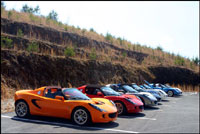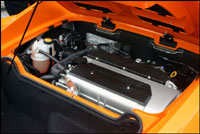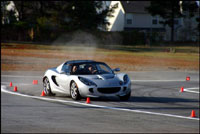I'd thought I'd driven a true purists' sports car before, having
Now there's a brand logo we haven't seen here in quite some time... (Photo: Trevor Hofmann, Canadian Auto Press)
piloted everything from Mazda's pesky little MX-5 Miata to Ferrari's superbly crafted F430, and most everything in between on the street and around race tracks, but while each has been wonderful in its own way, nothing could have prepared me for the ultra-light Elise.
In North America, anyway, nothing as inherently visceral exists. No car connects as intuitively to its driver, or relates as much information about what it is doing and what it's about to do. Certainly Mazda's little roadster is minimalist compared to an everyday midsize family hauler, and Porsche's Boxster is about as much fun as any open-top luxury sportster can get, but believe me when I tell you that even the agile Porsche feels like it's wearing lead boots when put side-by-side with the Elise.
 |
| You can't see it, but all seven Elises are actually anchored to the ground to prevent them from being blown away by the wind. (Photo: Trevor Hofmann, Canadian auto press |
 only makes sense, after all, what with a Boxster weighing in some 400 to 700 kilos (900 to 1,500 lbs) greater, depending on trim level, its factor in that the Elise comes equipped with an engine more powerful than even the top-line Mini Cooper S, by 22 horsepower no less, and it's easy to understand why a car with only 190-horsepower feels like a Ferrari at takeoff.
only makes sense, after all, what with a Boxster weighing in some 400 to 700 kilos (900 to 1,500 lbs) greater, depending on trim level, its factor in that the Elise comes equipped with an engine more powerful than even the top-line Mini Cooper S, by 22 horsepower no less, and it's easy to understand why a car with only 190-horsepower feels like a Ferrari at takeoff. Few cars can manage a sub-5-second sprint to 100 km/h (4.9s to be exact), much thanks to its thorough use of aluminum, blatantly exposed inside the cabin, and rigid composite body panels - even the exterior paint has been scrutinized to make sure its not adding excessive weight. Actually, I've never been around a team of engineers so obsessed with weight reduction (no doubt we journalists should be so concerned). Need to know the weight of the right front fender, each individual seat, the gas cap... they can tell you. Fortunately their somewhat disturbing preoccupation has resulted in a car that can transform Toyota's peaky little 1.8-litre four, with a rather thin torque curve maximized at 6,800 rpm to 138 lb-ft, into a blistering performer.
suspension is more taxed and engine needs to put out a lot more power to achieve the same levels of performance. The Elise, on the other hand, weighs only 900 kilos (1,984 pounds) in base trim, which in perspective is only 140 kg (309 lbs) more than the smallest car currently being sold in Canada, the smart fortwo, and 245 kilograms (540 pounds) less than a base Mini Cooper, the smallest car available in Canada before the smart came along. Then
 |
| Not only does it shift the Elise, the high-revving engine creates a rather joyous sound. (Photo: Trevor Hofmann, Canadian Auto Press) |
No comments:
Post a Comment